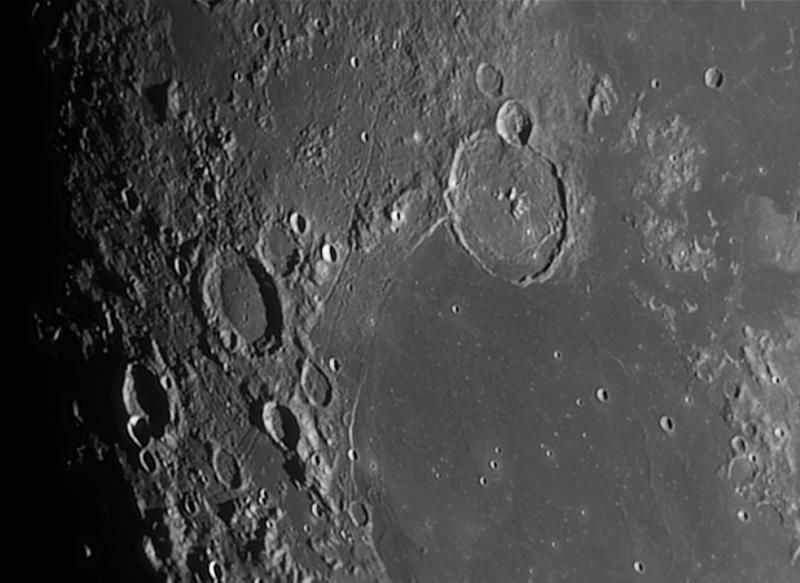On the north edge of Mare Humorum is the large crater Gassendi, which was considered as a possible landing site for Apollo 17. To the south are the floor-fractured Vitello crater, the partially flooded Doppelmayer, and the smaller Puiseux. To the east are Hippalus crater and Promontorium Kelvin. To the west are the Rimae Doppelmayer and the Rupes Liebig, which are cliffs near Liebig itself which is just west of the mare.
Mersenius is a lunar impact crater that is located to the west of the Mare Humorum, in the southwestern part of the Moon. To the southwest is the crater Cavendish, and to the south-southeast lies Liebig. Mersenius is 84 kilometers in diameter and 2.3 kilometers deep. It is from the Nectarian period, 3.92 to 3.85 billion years ago.
The rim of Mersenius is heavily worn, especially in the low northern section. The crater Mersenius N lies across the southwestern rim. The interior has been flooded by basaltic lava, which bulges upwards forming a convex domed shape with an estimated height of 450 metres relative to the floor edges. This was most likely formed by lava upwelling beneath the surface. There are several tiny craterlets across the floor surface, but little in the way of a central peak. At least two faint rilles lie along the surface of the floor.
To the east of the crater on the surface and edges of the Mare Humorum is a rille system designated Rimae Mersenius. These rilles are generally parallel and run to the north-northeast for a length of about 230 kilometers.
The crater is named after the 17th-century French philosopher and physicist Marin Mersenne.
En el extremo norte de Mare Humorum se encuentra el gran cráter Gassendi, que fue considerado como un posible lugar de aterrizaje para el Apolo 17. Al sur se encuentran el cráter Vitello fracturado en el piso, el Doppelmayer parcialmente inundado y el Puiseux más pequeño. Al este se encuentran el cráter Hippalus y el Promontorium Kelvin. Al oeste están Rimae Doppelmayer y Rupes Liebig, que son acantilados cerca de Liebig, que está justo al oeste del mar.
El borde de Mersenius está muy gastado, especialmente en la sección baja del norte. El cráter Mersenius N atraviesa el borde en su sector suroeste. El interior ha sido inundado por lava basáltica, que se abulta hacia arriba configurando una forma abovedada convexa con una altura estimada de 450 metros con respecto a los bordes de la plataforma del cráter, originada muy probablemente por la presión de la lava bajo la superficie. Presenta varios pequeños cráteres sobre la superficie del suelo, aunque muy pocos en las inmediaciones del pico central. Al menos dos débiles grietas surcan la superficie del cráter.
Al este del cráter, en el borde litoral del Mare Humorum aparece un sistema de grietas denominado Rimae Mersenius. Estos surcos son generalmente paralelos y discurren hacia el norte-noreste durante una longitud de cerca de 230 kilómetros.
El cráter lleva el nombre del filósofo y físico francés del siglo XVII Marin Mersenne.
(Fuente: Wikipedia) |

